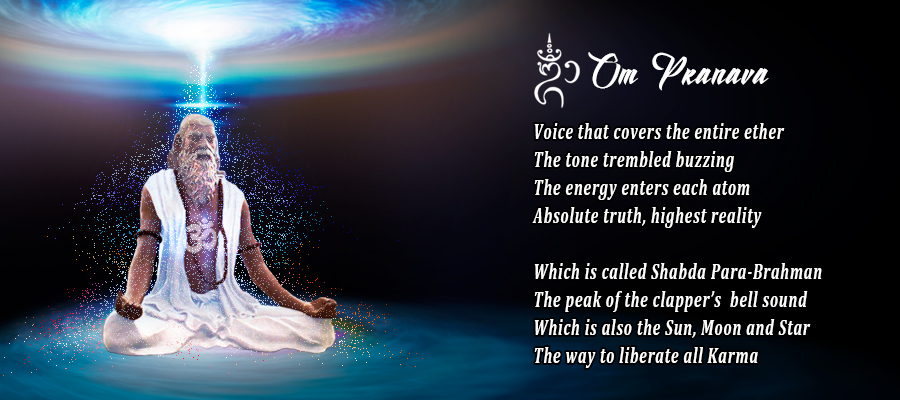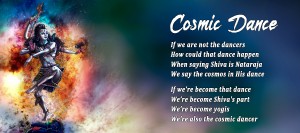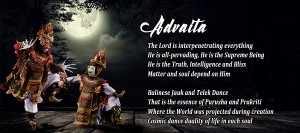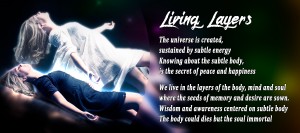The cosmic sound is associated with the creation of the universe. It is believed that before creation, the humming of energy existed. That energy became the vibration of creation and so the universe was created out of the ever-present sound of Om. This cosmic sound and its vibration still exist around and inside everyone.
Cosmic sound is also known by the Sanskrit term, nada. Nada yoga philosophy believes all things – living or inanimate – consist of nada. Through meditation, the yogi creates space for the cosmic sound. Likewise, the “Hatha Yoga Pradipika” text says when a yogi reaches the supreme state, the cosmic sound can be heard.
Today, chanting Om in concert with meditation brings one closer to unity with the universe. Depending on the specific tradition, this can also be called unity with the Divine, Absolute Reality, the Higher Self, God or Brahman, The energy of the universe enters the body, creating strength and energy, and the desire for possessions and attachments disappears because the yogi is one with all things.
Nada is the Sanskrit word for “sound” or “tone.” Many yogis believe that nada is the hidden energy that connects the outer and inner cosmos. Nada yoga, or nada philosophy, is based on the premise that the entire universe consists of sound vibrations called nadas. The words, nada yoga, can be translated to mean “union through sound.” This ancient Indian system follows a science of inner transformation through sound and tone.
There are two types of nada: Ahata, which is external sound perceived by the body/mind, and Anahata, which is an internal sound that is perceived by the heart chakra.
OM or OMKARA
Omkara is the primordial sound from which the whole universe was created. Om is also called the shabda Brahman, God as sound/vibration.
In the Yoga Sutras of Patanjali, Aum (Om) is spoken of as the symbol of Ishvara or God. This great authority on yoga refers to Aum as a Cosmic Sound continuously flowing in the ether, unutterable by any human voice, and fully known only to the illuminated. Further, Patanjali says that deep concentration on Aum is a means of liberation. Many people who do not understand the inward meaning of the scriptures think that by softly or loudly chanting Aum they can reach the superconsciousness. The Hindu scriptures, however, point out that one whose mind is identified with the kaya or body cannot possibly perceive the true Aum sound. (…) In point of fact, none can escape a constant communion with Aum, for it pervades the consciousness and every fiber and atom of every being. Those who become consciously attuned to the omnipresent Cosmic Vibration receive untold blessings.
Super conscious chanting, however, is that in which the mind is deeply directed to the repetition of, and the actual profound listening to, the Cosmic Sound as it vibrates in the ether. This is the true way of contacting God as He is expressed in creation.
The vocal chanting of Aum should be intoned first in a high pitch, representing creation; then in a lower pitch, representing preservation; then in a still lower tone that gradually fades away, representing dissolution.
The chanting should be first loudly, then softly, and then gently until it is inaudible, or mental only. The real, or superconscious, chanting of Aum, however, consists not in an imitative vocalization of Aum, but in actually hearing the Holy Sound.
All physical sounds are transmitted through the medium of ether; but although Aum vibrates in the ether—which is the background of all manifested activity the Aum sound vibrates independently of the etheric medium.
It is thus referred to as anahata-nada (a sound produced otherwise than by being beaten or struck that is, without detonation) because it manifests in the yogi’s intuition without striking his eardrum through the medium of ether—as with physical sounds. Aum, being a spiritual vibration, is not heard physically, but felt spiritually Patanjali meant that only that yogi can attain God whose mind is superconsciously fixed on the Cosmic Sound, the external Divine Manifestation. Such a yogi is an accomplished brahmachari. His heart is overflowing with the sacred joy that follows perception of Aum.
When a devotee experiences the bliss of God behind the Cosmic Sound, his heart becomes serene. A yogi who has united his soul with the Cosmic Sound and thereby experiences its ineffable bliss is spoken of as united to the Lord. His heart, filled with divine joy, is no longer subject to likes and dislikes, as is the ordinary person’s heart during the contacts with matter and its essential oppositional states. An avowed man of renunciation, fearlessly, with serene heart and controlled mind, can think of God as his Supreme Goal.
In a higher state the yogi becomes one with God; having found the Lord through Aum and Its pratipadya (the cosmic bliss that follows after the Cosmic Sound), he achieves complete liberation.
The Unmanifested, The Infinite, the Changeless Spirit is called Para-Brahman: the One Absolute. But during the cycles of manifestation, the Nameless and Formless is described as Aum-Tat-Sat (or, of Sat-Tat-Aum) so designated by the ancient sages. Invisible Vibratory Power, the direct creator and activator of all creation.
As the calm ocean without waves and the ocean with waves in tumult are one and the same in essence, differing only in appearance, so also the Unmanifested Sea of Spirit (Parabrahman) and the Manifested Sea of Spirit (Aum-Tat-Sat) are the selfsame Sole Reality, differing only in form.
God as Sat is the Father of creation (Ishvara), though He exists beyond it. God as Tat is the Son or Christ (Krishna or Kutastha) Intelligence that pervades the universe. God as Aum is the Creative Vibration that upholds the worlds through Prakriti, Mother Nature, His consort. It is the macrocosmic triple conception that has established itself in the microcosmic human relationship of father and mother and their reflection in their offspring.
Man displays in himself the three divine manifestations. His body is the result of Aum or vibratory forces. His Christ Intelligence or Tat exists in his omniscient spiritual eye between the eyebrows. This Intelligence, individualized as his soul, is a reflection of Cosmic Consciousness or Sat residing in the thousand-petaled lotus in the brain.
These three measures of Spirit incarnate in man “from the beginning” are the Brahmins, Sat, “knowers of God,” the soul; the Vedas, Tat, the soul’s intuitive all-knowing intelligence; and the sacrificial rites, Aum, the vibratory life that creates and preserves the body, empowering it to perform its divine and dutiful rituals of existence including the ultimate sacrificial rites of yoga (one of which is meditation on Aum) that reunite the soul with Spirit. By this inherence, indigenous in the coming-forth of mortal beings, the Lord has endowed to man the way and the means and the irrevocable assurance of salvation.
All yogis who perform the sacrificial rite of listening to the omnipresent holy vibration of Aum attain cosmic perception, Veda, and by this expanding blessedness ascend to cosmic consciousness and become Self-realized souls, the true Brahmins or “knowers of Brahman.” Aum is the all-pervading sound emanating from the Holy Ghost as it performs its work of creating and maintaining the universal structure. Aum is the voice of creation, testifying to the Divine Presence in every atom.
Aum is the divinely empowered creator of all things; it manifests itself as cosmic light and cosmic sound. As the ocean roar is a conglomerated sound of all waves and is manifested in each wave, so the cosmic sound and the cosmic light are the aggregate of all animate and inanimate creation, and are manifested in each man as the light of life and may be heard by him as the astral sound of Aum.
Similarly, as the devotee listens to Pranava OM, the holy sound of Aum, he forgets the restrictions of the human body and of space and can feel the Aum of his body vibrating into a perception of his cosmic body. He feels his consciousness vibrating everywhere with the ever expanding Aum sound. In ecstasy he suddenly sees his body as an atom or cell in the cosmic body.
Audible utterance of “Aum” produces a sense of sacredness, even as a devotee feels awe at the sound of the word “God.” At the beginning of all acts and rituals, repetition of the holy syllable, “Aum,” the Pranava, symbol of the Divine, removes the taints and defects that inhere in all human activities, even the highest ones. However, real understanding of Aum is obtained only by hearing it internally and then becoming one with it in all creation.
That is why the ancient sages prohibited the study of the Vedas to those who were kayastha (body-identified) and thus unreceptive to the cosmic sound, Aum.
By the right method of meditation as the light of the spiritual eye and the holy sound of the cosmic vibration of Aum (Om), any persevering devotee, by constant practice, can experience the blessings of the manifested vibratory presence of God.
One who can hear, feel, and spread his consciousness in Aum—can understand and communicate in the diverse tongues of inspirations. He truly communes with Nature, not as an experience of the senses, but as one united with the Voice of God through which the Creator guides the symbiosis of His beings in an underlying harmony.
All human beings are born of the Creative Vibration of the Holy Ghost, but they are prodigal sons who have left the home of their parental Divine Consciousness and have identified themselves with the finitely limited territory of the human body. The soul feels confinement in the physical, astral, and ideational bodies. At the onset of spiritual awakening, that Self begins to assert its connate desire for freedom from delusion’s constraints. The conscious mind should then be taught how to detach the soul consciousness from identification with these three bodies to reclaim its origin in the omnipresent Spirit.
The Astral Sounds of OM (AUM)
This Holy Vibration working in the subtle spinal centers of the astral body, sending forth life force and consciousness into the physical body, manifests as wonderful astral sounds—each one characteristic of its particular center of activity.
These astral sounds are likened to melodic strains of the humming of a bee, the tone of a flute, a stringed instrument such as a harp, a bell-like or gong sound, the soothing roar of a distant sea, and a cosmic symphony of all vibratory sound. The technique of meditation on Aum teaches one to hear and locate these astral sounds. This aids the awakening of the divine consciousness locked in the spinal centers, opening them to “make straight” the way of ascension to God-realization.
As the devotee concentrates on Aum, first by mentally chanting Aum, and then by actually hearing that sound, his mind is diverted from the physical sounds of matter outside his body to the circulatory and other sounds of the vibrating flesh.
Then his consciousness is diverted from the vibrations of the physical body to the musical vibrations of the spinal centers of the astral body. His consciousness then expands from the vibrations of the astral body to the vibrations of consciousness in the causal body and in the omnipresence of God.
When the devotee’s consciousness is able not only to hear the cosmic sound of Aum, but also to feel its actual presence in every unit of space, in all finite vibrating matter, then the soul of the devotee becomes one with the Jivatman. His consciousness vibrates simultaneously in his body, in the sphere of the earth, the planets, the universes, and in every particle of matter, space, and astral manifestation.
Through the expanding power of Jivatman, the all-spreading Aum vibrating sound heard in meditation, the consciousness then becomes immersed. These progressively higher states of realization are attained through deeper and longer meditation as guided by the guru.
Chanting Om during the practice of yoga causes the practitioner to experience its distinct syllables and the physical vibrations they each produce.
Anagata (silence) – This significant phase of the Om invites yoga practitioners to fully experience the blissful state of silence and the sense of unity it transmits
Inner Peace and Joy
The uplifting vibrations of “the Comforter” bring profound inner peace and joy. The Creative Vibration vitalizes the individual life force in the body, which conduces to health and well-being, and can be consciously directed as healing power to those in need of divine aid.
Being the source of intelligent creativity, the Aum vibration inspires one’s own initiative, ingenuity, and will. To know God is not the negation of desires, but rather complete fulfillment.
Just as by feeding somebody else one’s own hunger cannot be appeased, so the soul can never be satisfied by catering to the senses. The senses crave indulgence, greed, and temptations to excite and amuse them; the soul feels fulfilled only by the calmness, peace, and bliss bestowed by good action and the moderate use of the sensory instruments.
Ambition for good things, noble achievements, and spiritual work, serving the many, should be instituted to displace selfishness and greed, and the limiting circumscription of sole consideration for one’s self and one’s immediate family.
When undertaken in the thought of God, there is great enjoyment in all good work and achievements. By contacting God in the world and in good deed, karma and meditation, all desires of the heart are fulfilled; for nothing is more worthwhile, more pleasant or attractive than the all-satisfying, ever-new joy of God.
Desire limits the consciousness to the object of desire. Love for all good things as expressions of God expands man’s consciousness. One who bathes his consciousness in God becomes unattached to personal desires and objects while enjoying everything with the joyousness of God within our self.
First, the life force and consciousness must be withdrawn from the senses and bodily restlessness and must cross the portals of Cosmic Energy represented by the golden ring of the spiritual eye. Then the consciousness must plunge in the blue light representing Jivatman Consciousness.
This golden, blue, and silver light contains all the walls of rays electronic, atomic, and life of Cosmic Vibration through which one has to penetrate before one can reach heaven. In these highest states of meditation, the body itself becomes spiritualized, loosening its atomic tenacity to reveal its underlying astral structure as life force.
By deeper meditation still, the astral body becomes elaborated into the ideational body of consciousness. Then as pure wisdom, the ideational consciousness transcends the vibrations of the soul and becomes immersed in Jivatman, through which it ascends to Cosmic Consciousness.
In Sanskrit, the sound “O” is a diphthong spelled “AU”. A diphthong is the blending of two vowel sounds where both are normally heard and make a gliding sound. As a result, the difference between OM and AUM is simply one of transliteration.
Om is the primal mantra of this universe. It is the most sacred of bija (seed) -mantras. The Sanskrit letters A-U-M make up the Om mantra, as well as the unsounded after the “M”.
In the Mandukya Upanishad said that all past, present, and future is Om. It is also said that the Self is Brahman and Brahman is all that is.
The Mandukya Upanishad is an exposition on the mantra Om and how it relates to the three states of consciousness and the Fourth known as Turiya. The Mandukya Upanishad speaks of measures of Om. These measures have corresponded to the waking, dreaming and deep sleep states, and the silence after Om.
The Mandukya Upanishad explains that the waking state (jagrat) is when knowledge is directed outwardly, in the dreaming state (svapna) it is directed inwardly and in the deep sleep state one has no desire for wishes, and in the fourth, Turiya one is beyond all these. The fourth is the soundless aspect of Om. When the self is known by all cessation of phenomena, even bliss, then the soundless aspect becomes known as the Self. One with direct experience of this expands to Universal Consciousness.





